Hi, I’m Ezra—and I’ve sold over $5 million dollars in design, development, and marketing services to ecommerce business owners.
After sitting in hundreds of sales meetings, I realized that there was one question that every prospective client wanted answered. If I answered this question well, I would close the sale and gain a new client; if I answered it poorly, I would walk away empty handed.
"That fundamental question is: 'How will you help me grow my business?'"
That fundamental question is: “How will you help me grow my business?”
I’ve been thinking about this a lot lately, as I’m a judge for this years Shopify Commerce Awards, and one of my categories is Best Abandoned Cart Recovery Experience.
Through my ecommerce marketing blog, I get the opportunity to relate with tens of thousands of Shopify store owners each year, and the number one request I get is for marketing and automation services.
There is a HUGE opportunity for agencies that support Shopify stores to offer more marketing and automation based services. When done properly, abandoned cart automation sequences can be a MAJOR driver of sales for store owners. They are also an easy place to start if you’d like your agency to start offering marketing and automation services.
One of the main reasons they’re such a great place to start is because cart abandonment is happening…A LOT. According to Baymard.com, 69.23 percent of shopping carts are abandoned on average. That’s nearly seven out of every 10 carts!
So if you are going to offer cart abandonment set up as a service, let’s talk about how you can knock it out of the park for your clients!
Looking to brush up on your business email writing skills in general? Check out our articles on the best business email format or subscription based email marketing.
Our best email sequence for an abandoned cart
When creating an abandoned cart strategy, the first thing to understand is that you 100 percent want to send multiple emails. I would recommend a minimum of one a day, for five days.
Ecommerce customers who receive multiple abandoned shopping cart emails are 2.4 times more likely to complete the purchase than those who receive only one follow up email. And customers who receive multiple abandoned cart emails have a multiple transaction rate 44 percent higher than those who didn’t.
In the last 12 months on our store, our abandoned cart email automation sequence has been the most profitable automated email series on a $/recipient basis. But it wasn’t always this way. To see why it’s working so well, let’s take a look at the actual emails we send.
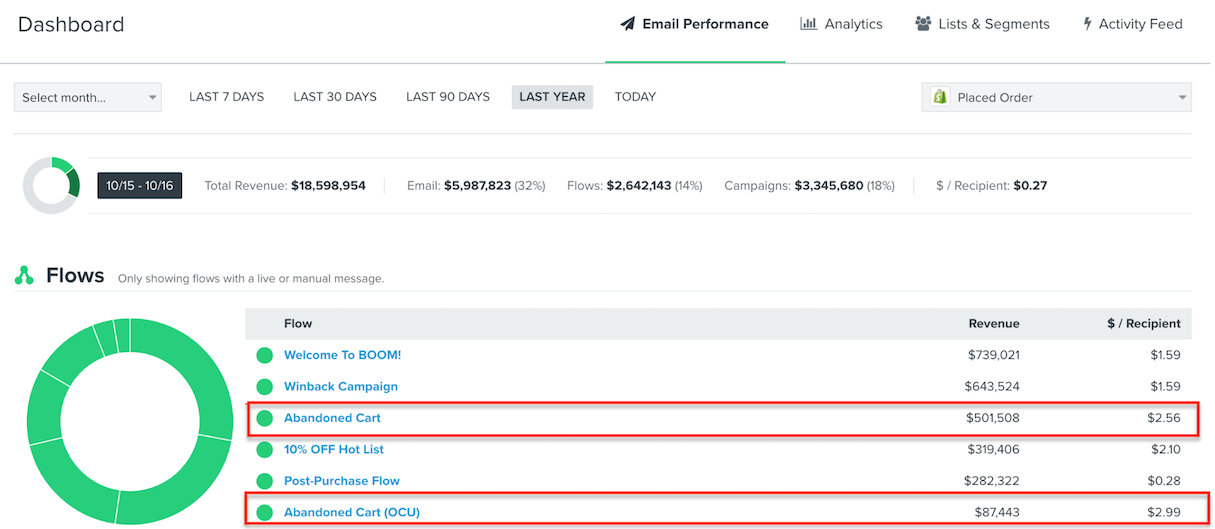
The goal of every abandoned cart email is simple: Close the sale! Here are the main elements we’ve found work in abandoned cart emails:
- Urgency
- Scarcity
- Ownership benefit content
- Brand value proposition content
- Discount ladders
If done properly, the first email that goes out will always be the most profitable. Let’s take a look at an example of an automated email sequence for customers who have abandoned their shopping cart.
Email #1
Send schedule: Four hours after abandoning cart.
Subject: Your order is still open, finish it before we run out of stock.
Purpose: Close the sale. Communicate urgency.
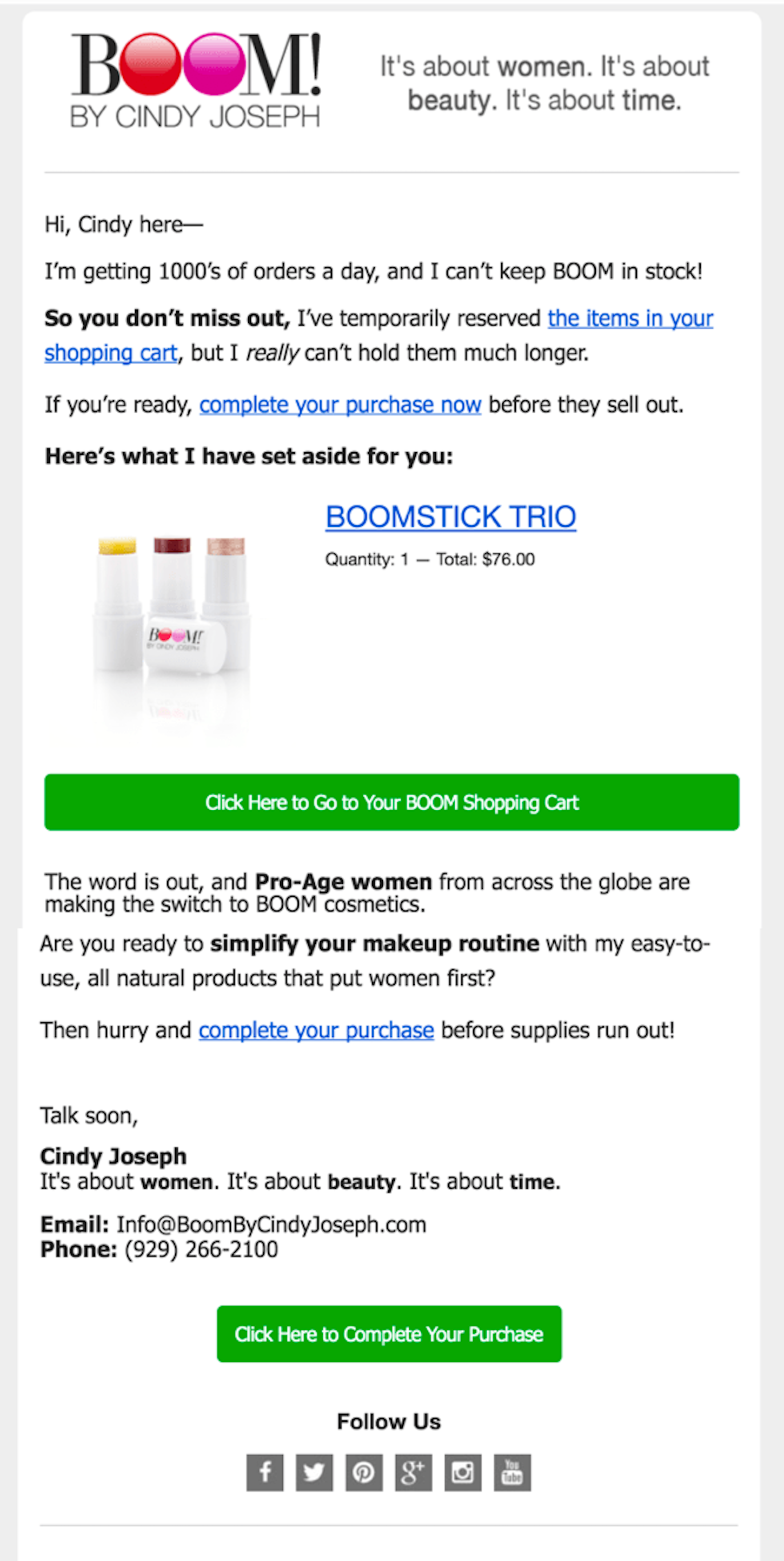
In this email, we let the prospect know that we’ve reserved their order and that they can now go back and finish it. This store runs on a limited supply chain, so we use that fact to our advantage by communicating urgency: We say we’ve “temporarily reserved” their order, and that they should finish purchasing “before they sell out.”
Notice how this email (and all others) has a hero shot of the product from the abandoned cart dynamically inserted into the email, with blue underlined text calling readers to action, as well as call to action buttons.
Below are the results of this email over the past 30 days. Notice how high the open/click rates are. If you are not seeing this level of open/click on your first email, you may want to test rewriting the subject line and body content.
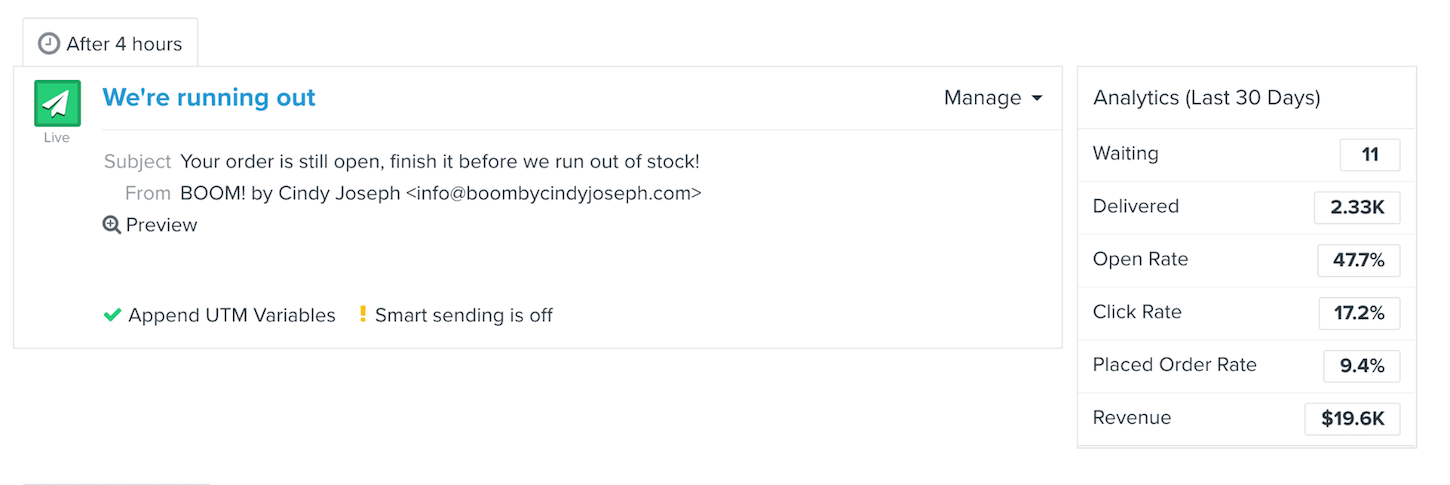
|
Analytics (Last 30 Days) |
|
|
Waiting |
11 |
|
Delivered |
2.33K |
|
Open Rate |
47.7% |
|
Click Rate |
17.2% |
|
Placed Order Rate |
9.4% |
|
Revenue |
19.6K |
I was shopping at a store called Buck Mason recently and I abandoned my cart. I thought their initial email (below) was quite good. It had a compelling subject line, a dynamic insertion of the product, and a call to action button. The only issue I have with them is that this was the only email they sent! (Come to think of it, maybe I should go back and buy that Charcoal Twill Trouser!)

Email #2
Send schedule: 24 hours after abandoning cart.
Subject: Last chance before your cart expires.
Purpose: Close the sale. Communicate urgency.
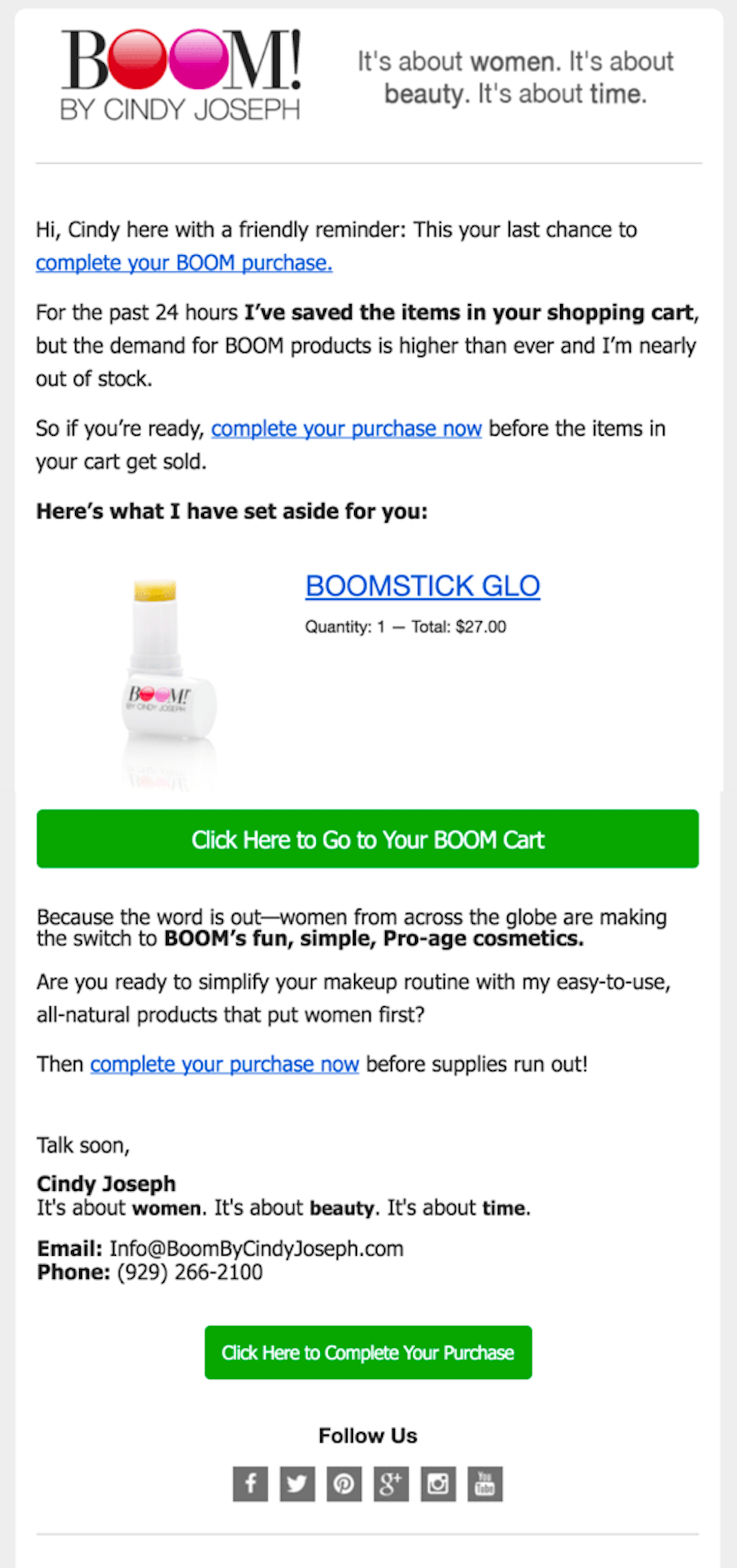
In this email, we use nearly identical content to the first email. We remind the prospect that their order is on hold and ask them to complete the order.
Below are the results of this email over the past 30 days. Notice how we have not incentivized users to complete their order by offering a discount. Most people go straight to offering a discount and miss out on converting the folks who were the most interested.

|
Analytics (Last 30 Days) |
|
|
Waiting |
55 |
|
Delivered |
2.04K |
|
Open Rate |
38.9% |
|
Click Rate |
12.0% |
|
Placed Order Rate |
5.0% |
|
Revenue |
$9.02K |
Email #3
Send schedule: Two days after abandoning cart.
Subject: Hallmark Home and Family’s Beauty Tips.
Purpose: Social proof, education about brand, establish authority.
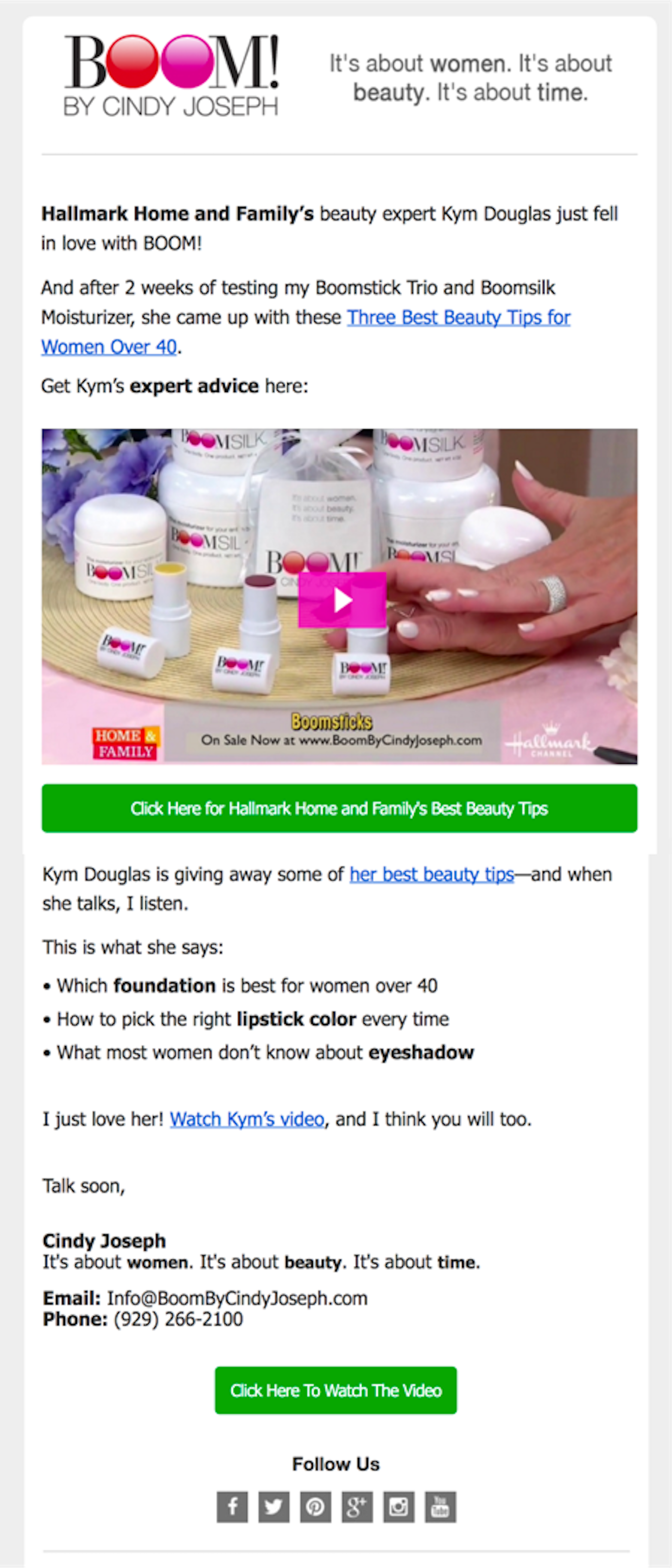
In this email, we make the pivot from leveraging scarcity and urgency to leveraging product ownership benefit content, and brand value proposition content. We do this by emailing a piece of social proof where a third-party endorses our products. Note that this email, unlike the previous two, does not link the user back to their abandoned shopping cart but rather to a video on our site:
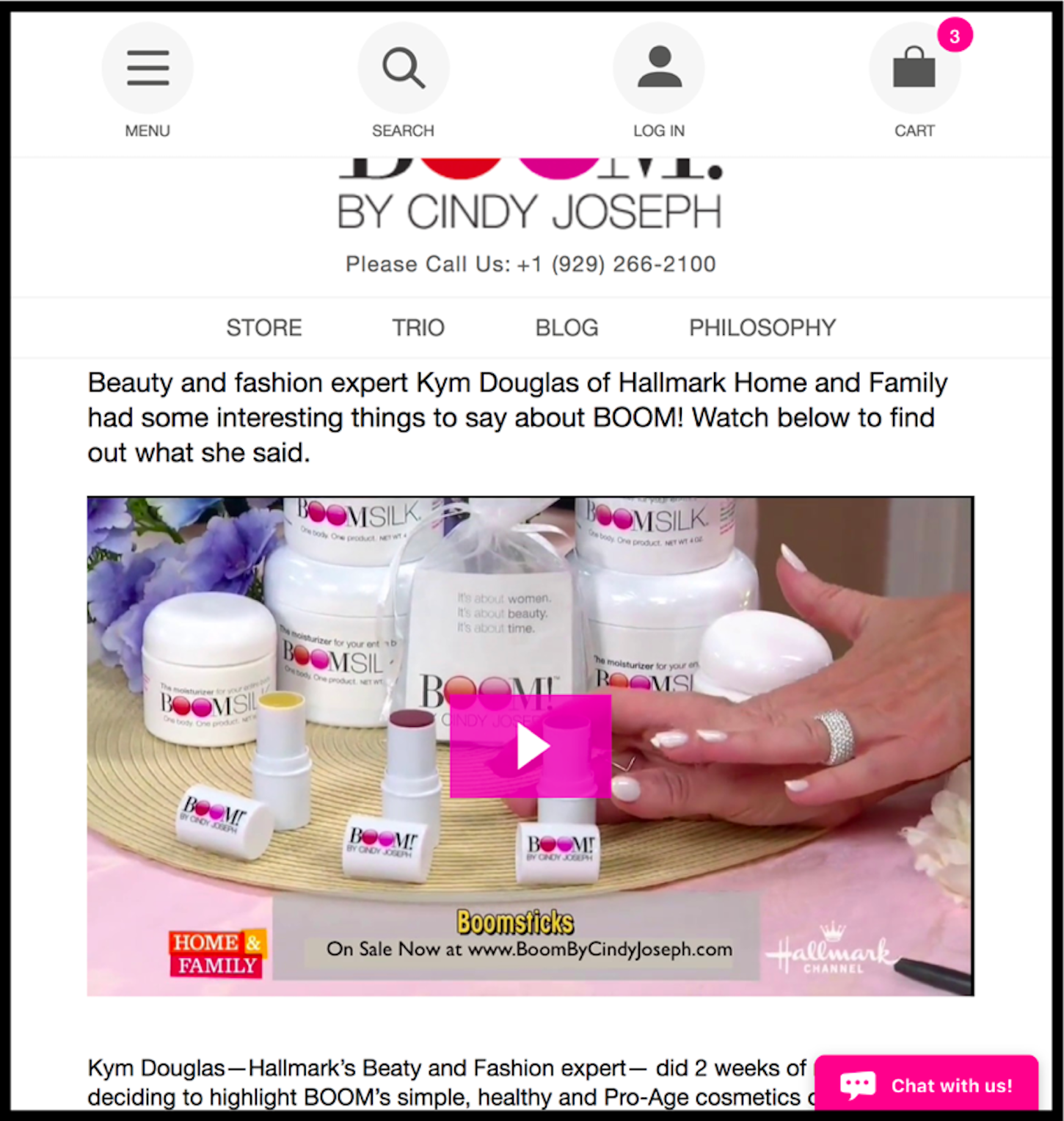
If the brand you’re setting this sequence up for doesn’t have a piece of professionally-produced social proof content, then you can use a customer testimonial video. Customer testimonial videos work extremely well in this spot, especially when they include a product demonstration.
Below are the results of this email over the past 30 days. Some people may look at these numbers and think they are comparatively small and not worth the time to set up.
I would agree, that yes, the number of purchases from this email are small compared to the first two emails, but the goal of this email is not ONLY to sell…it’s also to establish trust and authority with the prospect. When done well, this email makes the following emails in the sequence even more powerful!
"When done well, this email makes the following emails in the sequence even more powerful!"
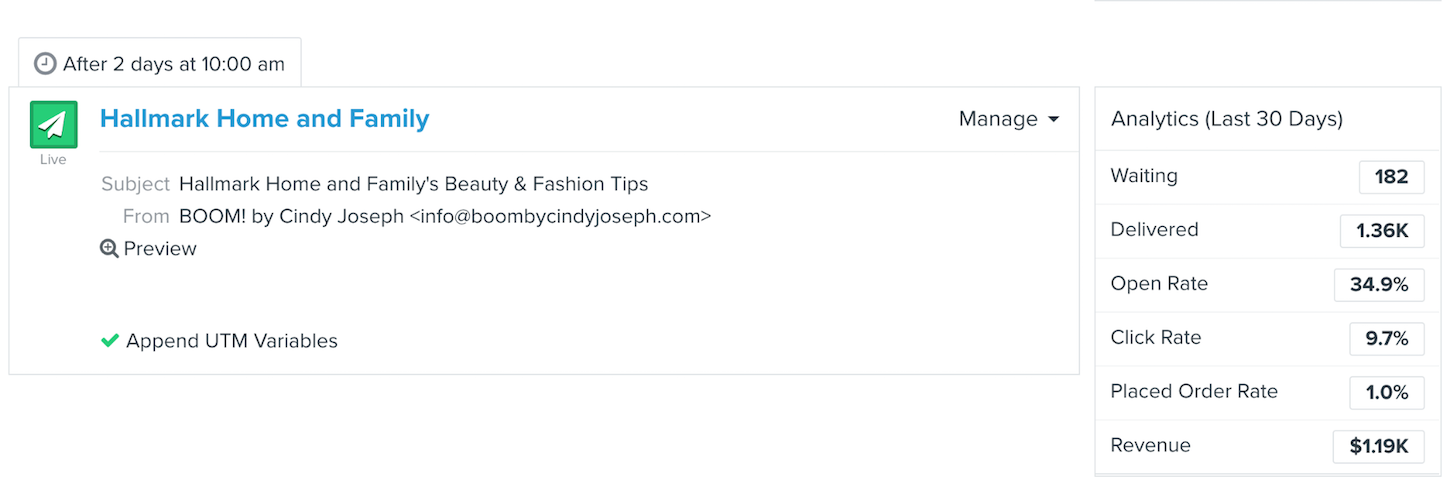
|
Analytics (Last 30 Days) |
|
|
Waiting |
182 |
|
Delivered |
1.36K |
|
Open Rate |
34.9% |
|
Click Rate |
9.7% |
|
Placed Order Rate |
1.0% |
|
Revenue |
$1.19K |
Email #4
Send schedule: Four days after abandoning cart.
Subject: Get 10% off all BOOM! products.
Purpose: Convert non-buyers. Offer discount.
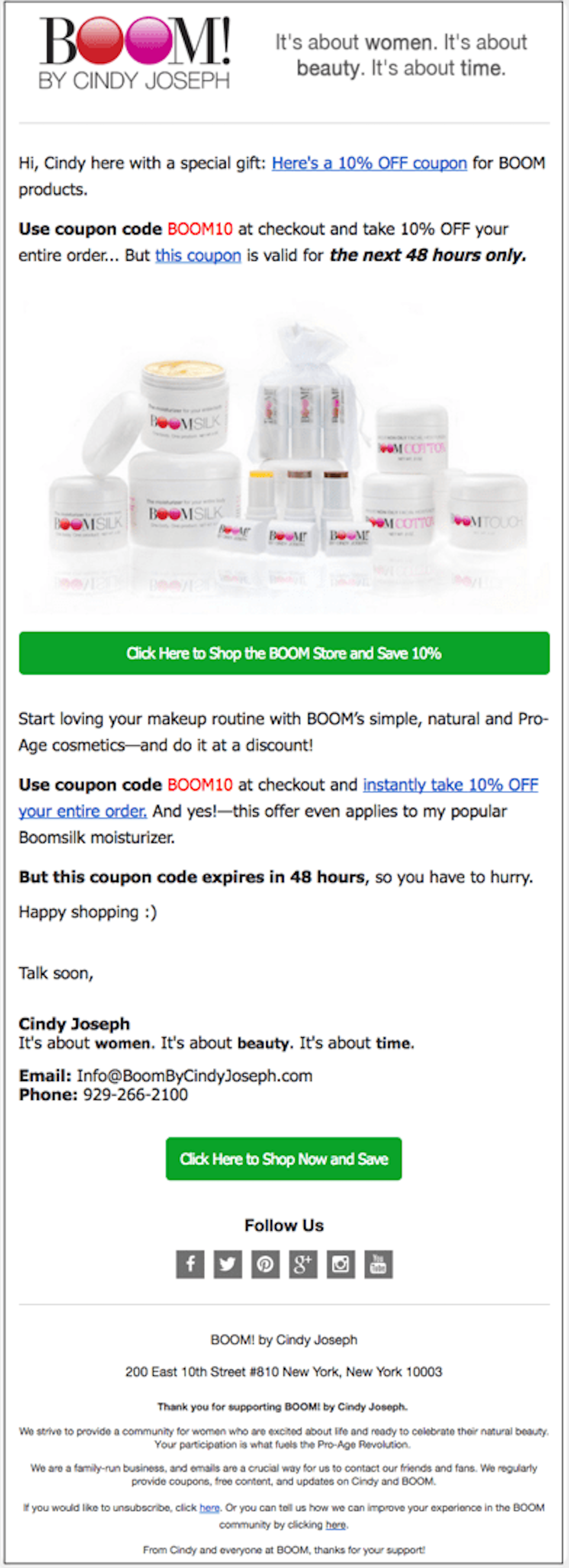
At this point, it’s been four days since the shopping cart was abandoned. To apply heavier pressure to close this sale, we start our discount ladder and offer the prospect 10 percent off their purchase.
Notice that we put an expiration on the discount — not only does this give us an additional reason to email (to let folks know the discount is expiring), it also makes the discount campaign work significantly better.
According to psychologist Dan Ariely, fostering a sense of urgency by setting strict deadlines is a very effective way to overcome procrastination.
You might also like: Why Every Shopify Store Needs a Marketing & Sales Funnel.
Below are the results of this email over the past 30 days. This email has nearly five times the revenue of the previous email!
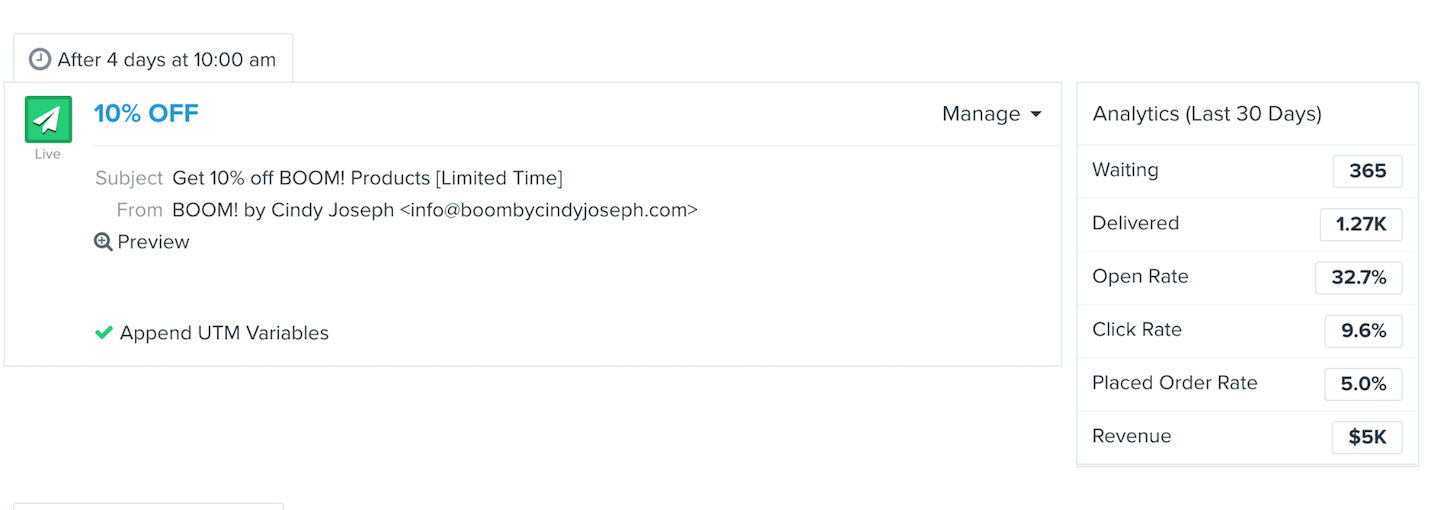
|
Analytics (Last 30 Days) |
|
|
Waiting |
365 |
|
Delivered |
1.27K |
|
Open Rate |
32.7% |
|
Click Rate |
9.6% |
|
Placed Order Rate |
5.0% |
|
Revenue |
$5K |
Email #5
Send schedule: Five days after abandoning cart.
Subject: My Live Makeover and Makeup Demo.
Purpose: Story, social proof, educate on brand, and establish authority.

In this email, we don’t mention the discount of the previous email but rather go right back into building a connection with the prospect via product ownership benefit content. Notice how we go back and forth between direct “ask” emails, where we ask for the sale, and content/informational emails, where we attempt to add value and support the user in making a decision.
This email links to a landing page with content on it, rather than linking to the cart.

Here are the results over the last 30 days:

|
Analytics (Last 30 Days) |
|
|
Waiting |
454 |
|
Delivered |
1.48K |
|
Open Rate |
28.0% |
|
Click Rate |
11.3% |
|
Placed Order Rate |
0.8% |
|
Revenue |
$784.32 |
Email #6
Send schedule: Six days after abandoning cart.
Subject: Last chance for 10% OFF Boom!
Purpose: Convert non-buyers. Offer Discount.
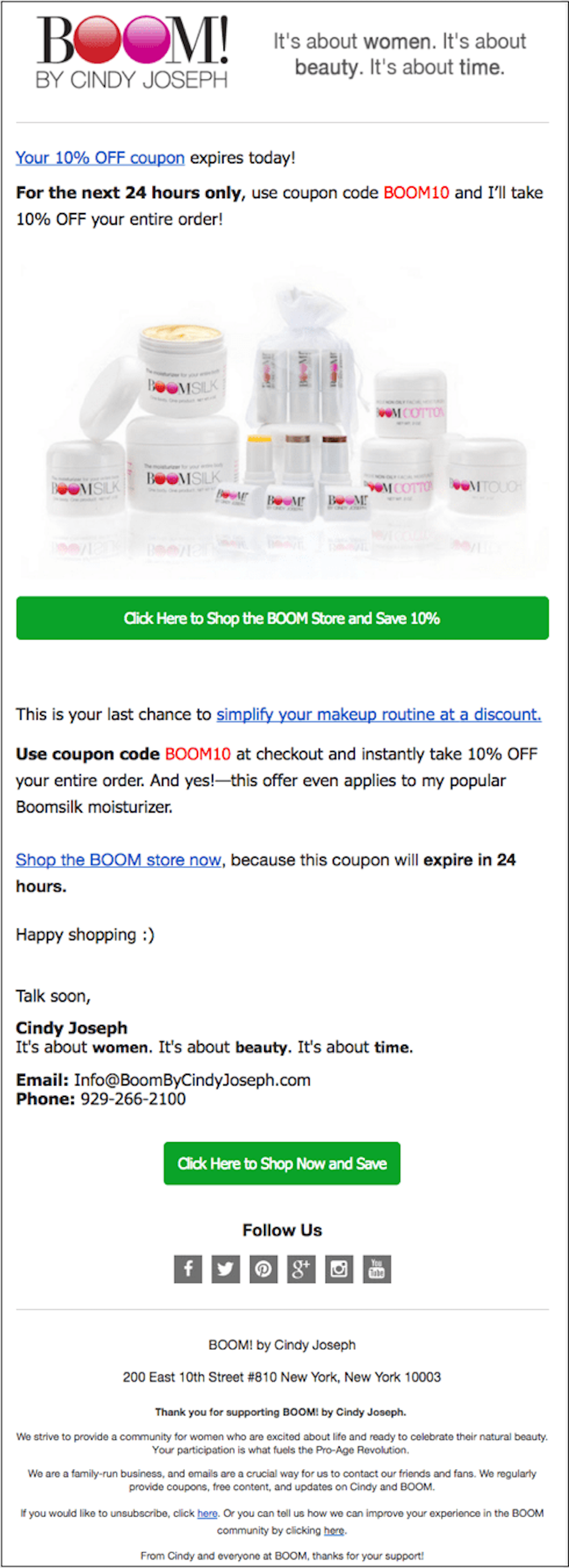
In this email, we combine our discount offer with urgency. We let the prospect know that this is their last chance to claim this discount if they’re still interested. The results are undeniable:
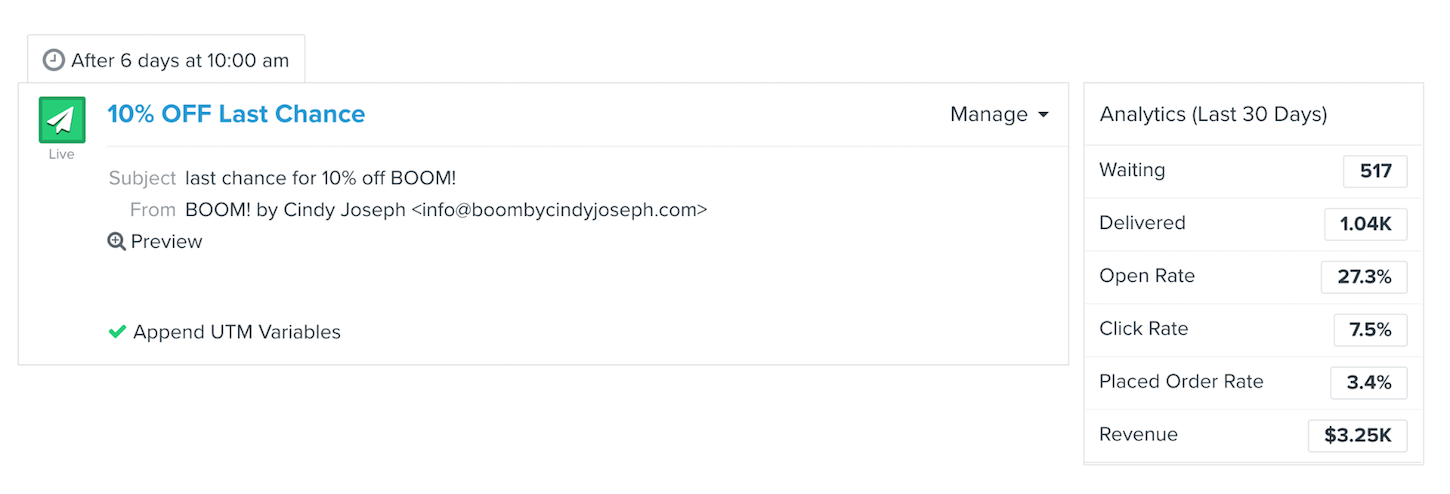
|
Analytics (Last 30 Days) |
|
|
Waiting |
517 |
|
Delivered |
1.04K |
|
Open Rate |
27.3% |
|
Click Rate |
7.5% |
|
Placed Order Rate |
3.4% |
|
Revenue |
$3.25K |
At this point, we’ve sent six emails in six days and we’ve recovered a lot of abandoned shopping carts because of it. Based on my experience setting similar sequences up for literally hundreds of stores, I would suggest this number of emails as the minimum to send.
If you want to go the extra mile, you can add even more communications to your automation pipeline. As you can see below, we actually send four more emails after this that focus on product ownership benefit education.
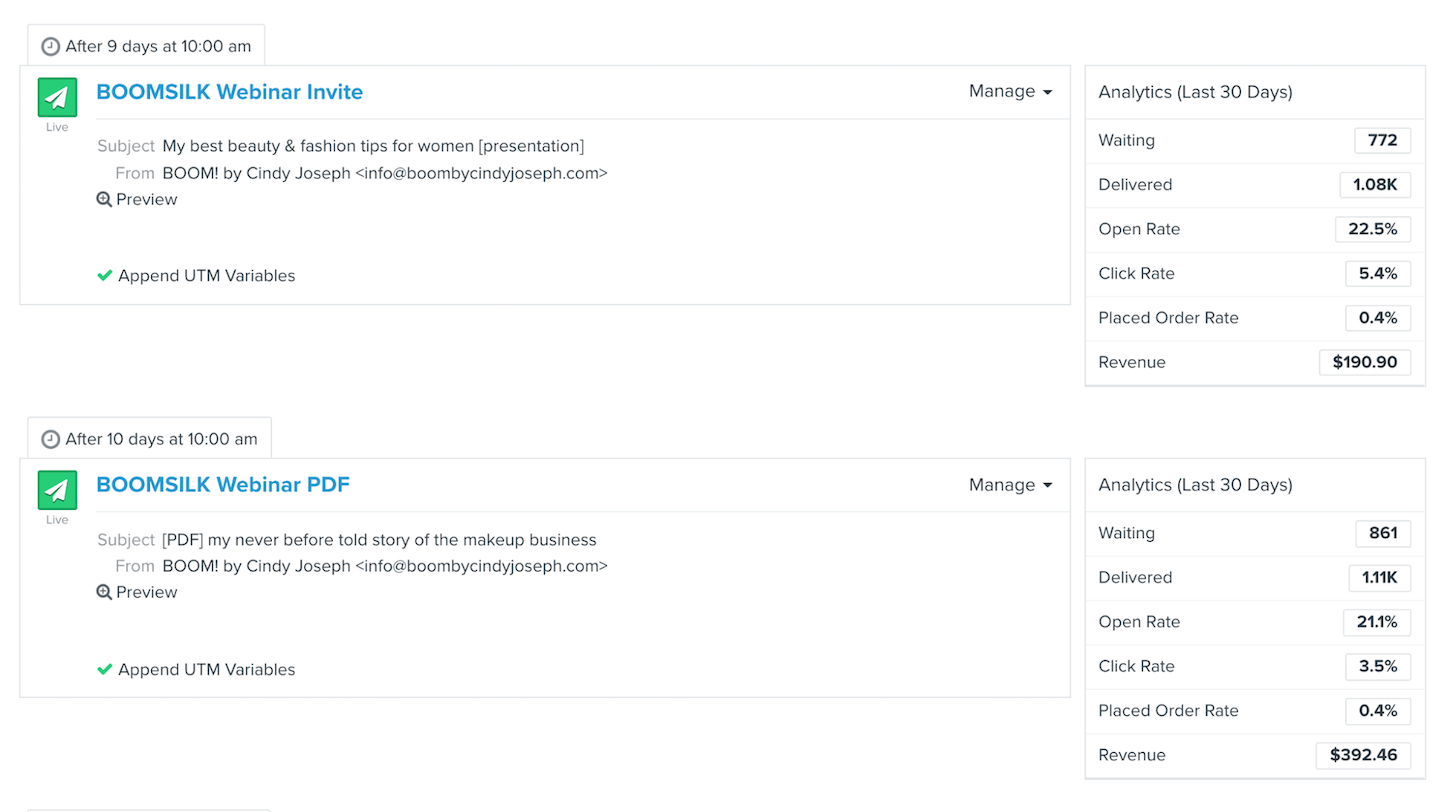
|
Analytics (Last 30 Days) |
|
|
Waiting |
772 |
|
Delivered |
1.08K |
|
Open Rate |
22.5% |
|
Click Rate |
5.4% |
|
Placed Order Rate |
0.4% |
|
Revenue |
$190.90 |
|
Analytics (Last 30 Days) |
|
|
Waiting |
861 |
|
Delivered |
1.11K |
|
Open Rate |
21.1% |
|
Click Rate |
3.5% |
|
Placed Order Rate |
0.4% |
|
Revenue |
$392.46 |
These two emails are are sending out “long form” content in the form of an educational webinar (90 minute video) about our brand and products.
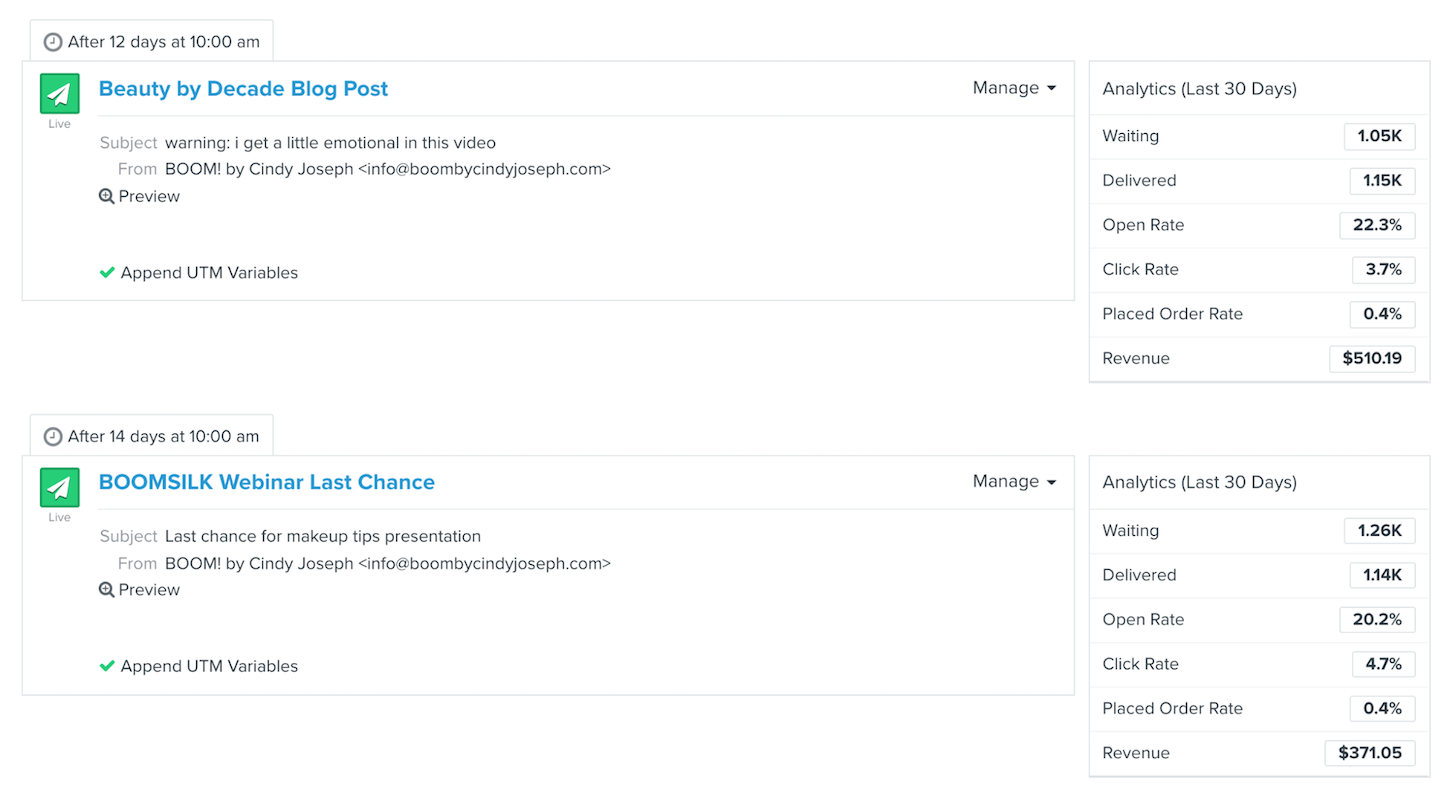
|
Analytics (Last 30 Days) |
|
|
Waiting |
1.05K |
|
Delivered |
1.15K |
|
Open Rate |
22.3% |
|
Click Rate |
3.7% |
|
Placed Order Rate |
0.4% |
|
Revenue |
$510.19 |
|
Analytics (Last 30 Days) |
|
|
Waiting |
1.26K |
|
Delivered |
1.14K |
|
Open Rate |
20.2% |
|
Click Rate |
4.7% |
|
Placed Order Rate |
0.4% |
|
Revenue |
$371.05 |
The blog post seen above is a short form video (5min) that summarizes our brand’s philosophy on one of our main market topics (aging).
Go deeper with automation sequences
Hopefully this article has inspired you to go a little deeper when setting up automation sequences for clients (or at least has shown you the potential of doing so).
If you really want to hit a homerun for your client, you can combine this strategy with retargeting ads (to cart visitor non-buyers) on platforms like Facebook and Instagram.
Read more
- How to Build a Shopify App: The Complete Guide
- 5 Simple Google Analytics Reports for Your Clients [Templates
- How to Create a Customizable Announcement Bar Section in Shopify
- Build Forms on Shopify: How to Use Liquid to Build Robust Forms for Shopify Themes
- How to Customize Shopify Email Notifications for Clients
- 7 Tips to Calculate Your Freelance Rate
- Free Industry Report] The Future of the Fashion and Apparel Industry
- Top Freelance Resources on the Shopify Web Design and Development Blog
- Go Back to School With These Online Courses for Continuous Learning
- 9 Slack Integrations to Boost Your Team's Productivity
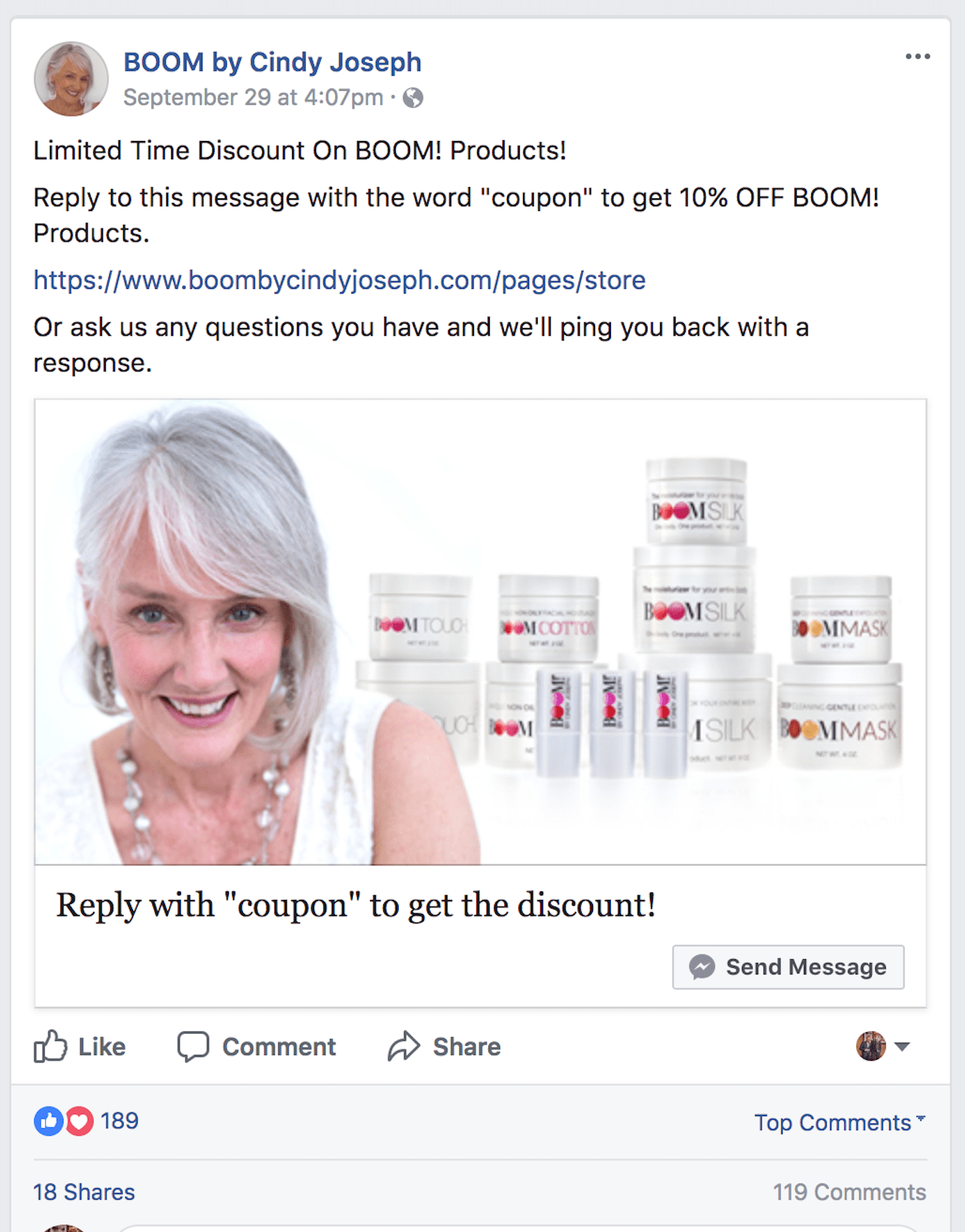
If you think about it, a brand is simply a group of people and multiple communication mediums . You want your clients to be present on as many communication mediums as possible (emails, ads, etc.), and you want their communications to be relevant, engaging, and aid prospects in the purchasing process.
. You want your clients to be present on as many communication mediums as possible (emails, ads, etc.), and you want their communications to be relevant, engaging, and aid prospects in the purchasing process.
I hope you’ve enjoyed this article!




